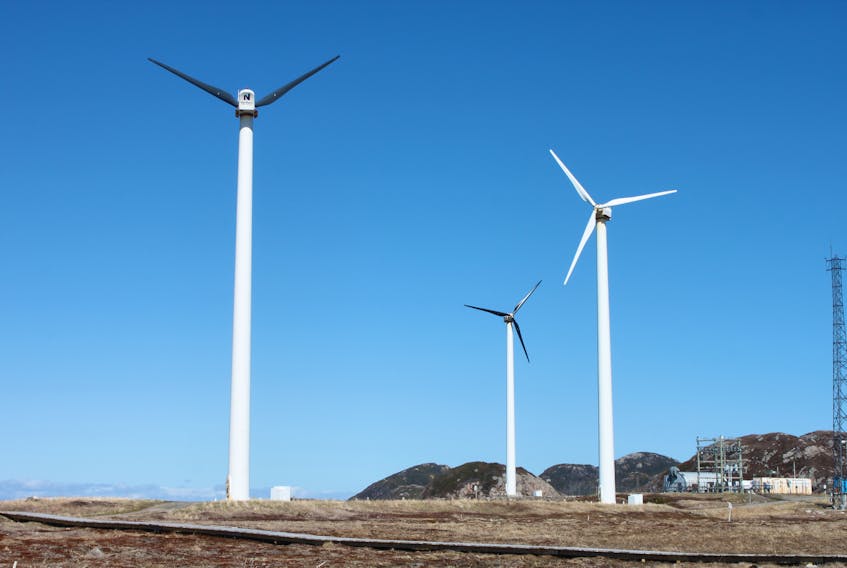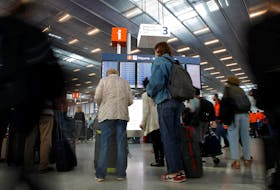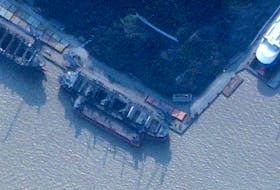FACT: Wind power has been looked at. How much could be safely added to the system was a point of contention. Now, it's the barriers set by the provincial government and Nalcor Energy to domestic sales.
Wind power was explored years before the heated public debate and decision on Muskrat Falls hydroelectric power to support the power grid on the island of Newfoundland. Newfoundland and Labrador Hydro (a Nalcor subsidiary) was involved in research on wind turbines for an isolated grid, permitted 54 megawatts (MW) in small wind projects at Fermeuse and St. Lawrence, and had gone to outside consultants seeking assessments on the province’s broader wind potential and how it might be tapped.
The 2007 Energy Plan showed the wind energy potential in the Canadian Wind Energy Atlas and suggested more than 5,000 megawatts (MW) in raw potential. The question was then a matter of policy — if more wind power was viewed favourably by the provincial government.

The Energy Plan spoke to that. “We have the potential to replace greenhouse gas-emitting energy sources with our clean hydroelectricity and wind, both here at home and in the North American marketplace,” it stated, pairing the two.
The next question was how much wind could practically be added to the island system, both to assure the basic demand for power was covered at all times and to maintain system stability.
The questions become: how much wind power can be added safely, where and when?
The technical challenge for the island was in being an isolated electrical grid. Without an interconnection to allow imports of power when wind is low, you have to assure there is enough hydroelectric (or other) power source to feed the need. Batteries to store wind power for support on an industrial-level, isolated system were still being researched, including in a Newfoundland and Labrador Hydro project at Ramea.
Hydro wanted a means to get off diesel power and use renewables for the province’s 21 isolated power systems, along coastal Labrador and around the island’s main grid, long before the Muskrat Falls debate.
Beyond the pure availability, there are technical considerations for the variations in wind power related to voltage, frequency and balancing the energy load, particularly as large amounts of wind are added to the existing system.
How much and when?
How much wind energy the island power system can handle remains a point of debate.
The 2007 Energy Plan suggested the island system could take about 80 MW in new wind. After that figure was published, it was publicly challenged during the debate ahead of the Muskrat Falls project’s sanctioning, particularly given time passed since the 2004 study the figure was based on. A new study on how much wind could technically, safely be added to the main island power system was commissioned. In August 2012, Hatch engineers reported (see page 322) the figure was higher — recommending the main Newfoundland grid could have 225 MW of wind serving under light load conditions in 2020 and 300 MW by 2035 (load growth allowing for more as time goes on). It suggested limiting to 500 MW installed serving the peak loads in winter.
The study assumed wind additions alongside three new, small hydro plants, a refurbishment of the Holyrood thermal power plant and three, new fuel-burning generators.
Different options were modeled and considered, but the final recommendation amounted to roughly 10 per cent wind energy, “which is high for an isolated system,” the consultant noted, while saying it was manageable.
RELATED STORIES
Lower Churchill before wind power (January 2011)
Forum speakers call for energy diversification (May 2012)
Evaluating options for isolated communities (May 2012)
Interconnected versus isolated
The study included a look at wind power in other jurisdictions, showing new wind was being included in power planning worldwide. There were European countries (Portugal 17 per cent wind, Spain 15 per cent) and 15 U.S. states with more than four per cent wind energy (the highest South Dakota at 22 per cent wind penetration), but also a catch.
“In general, the states listed above all have significant interconnections with neighbouring jurisdictions which enables load balancing during times of rapid wind generation changes,” the study notes. Sometimes the wind doesn’t blow, and sometimes it blows too much.

Nova Scotia, for example, is an interconnected grid.
Some isolated-grid systems were also looked at in the Hatch study, with Hawaii being one example.
“Total firm generation capacity on Oahu is 1,817 MW, comprising seven thermal generation plants, almost all burning fuel oil. The Hawaii Clean Energy Initiative, which was announced in 2008, includes a mandate for the state of Hawaii to generate 40 per cent of its energy from renewable resources by 2030,” it noted. That’s 40 per cent of any and all renewables, not just wind.
The U.S. Energy Information Administration (EIA) offers energy profiles for all States. For Hawaii, it notes oil fuelled two-thirds of the state’s net generation in 2016 and coal power accounted for about one-sixth. In recent years, about one-10th of the States GDP had been spent on importing oil, even as Hawaii has amongst the lowest electricity demand in that country.
“Hawaii’s dependence on imported petroleum combined with isolated island grids results in the highest retail electricity prices of any state in the nation,” the profile states.
For Newfoundland, Hatch recommended not more than 10 per cent wind. “Such a penetration rate is at the extreme edge of wind integration in any isolated system in the world. Exceeding it would not be considered good utility practice,” the company reported.
The numbers for the Newfoundland and Labrador “isolated island” alternative to Muskrat Falls were re-run on cost and reliability before the project was green-lit, this time settling on a planned alternative including 50 MW of new wind power capacity added every five years from 2015 to 2035, and the refurbishment of the existing wind farms on the island (as shown in Manitoba Hydro International’s updated isolated system plan from late 2012).
No wind allowed?
Some of the comments about wind not being considered at all for Newfoundland and Labrador are really about restrictions placed on wind development.
Wind power developments were being pursued in the province in the mid and late-2000s, including projects in Buchans and on the Burgeo highway.
In the 2007 Energy Plan, the provincial government decided on a new policy that Crown Land leases for potential wind power projects would only be issued to Newfoundland and Labrador Hydro or a company selected by it.
A separate issue arose in getting through environmental assessment. A wind farm for Argentia, by Wind Project Inc., was registered for assessment in January 2010. In January 2011, the provincial Department of Environment issued a notice stating: “The (cabinet) has declared as a matter of policy that there shall be no environmental assessment ... for wind energy projects which propose to produce energy for sale. Therefore, the province is not prepared to conduct an environmental assessment of the proposed project and the undertaking cannot proceed.”
Wind energy development was then limited through legislation, in amendments to the Electrical Power Control Act, Energy Corporation Act and Hydro Corporation Act through what was introduced as Bill 61, in the days after the sanctioning of the Muskrat Falls project in 2012.
The bill was debated in the province’s House of Assembly and ultimately the changes were brought into effect, with Newfoundland and Labrador Hydro given the exclusive right to distribute and sell electrical power to a retailer operating on the island, subject to certain exceptions, and requiring any retailer or industrial customer to buy from Hydro.
In other words, a private company could not develop wind power and related transmission and sell it direct. And individual home and business owners could not establish their own wind power generation without the say-so of Hydro, the competition.
Natural Resources minister at the time, Jerome Kennedy was asked about “the monopoly provision” keeping new entrants out of the marketplace. He said the revenue stream to cover the cost of the Muskrat Falls project had to be secured, and that it was “continuing the status quo” in terms of Hydro’s domestic monopoly. He also noted the legislation did not preclude developments for power export.
Offshore wind
In the 2010-2012 timeframe — in the lead-up to the green light for Muskrat Falls dam and a transmission link between the island and Labrador — it’s worth noting offshore wind power projects were getting much more attention in popular debate than they had up to that point.
Why not (and setting aside the issues associated with an isolated system) add more offshore wind to the mix? The answer is these projects were not without their limitations.
One offshore wind project has made it to first power since the Muskrat Falls project was approved. Deepwater Wind’s Block Island Wind Farm, off Rhode Island, achieved first power in December 2016. That project is rated at 30 MW, from five turbines. That’s compared to the 824 MW of the Muskrat Falls hydro facility.
There are over 20 offshore wind projects in progress now in the United States, but if and when they may each come to fruition is unclear. The goal is 86 GW online by 2050.
An offshore wind project mentioned by The Telegram at the time — the Cape Wind project in Massachusetts — was once meant to be the first for the United States, but was never realized. The New York Times reported in late 2017 that the project was abandoned 16 years into its development, after a construction milestone was missed and power purchase contracts were lost.
The Telegram also reported on the difficulties others had faced in Canada, including Vancouver-based NaiKun Wind Energy, pursuing an offshore wind farm in the Hecate Strait, with almost 400 MW of capacity from 110 turbines. Official consultations for that project dated back to 2003 and, at present, it is still in development (although with delays tied to settling a power purchase agreement, something unlikely to have affected a government-supported project in Newfoundland).
Offshore wind power is gaining steam, but the timelines were all notable for a Crown corporation and government hearing debate around supply options in 2010-2012, with forecasts indicating shortages as soon as 2014 and a failing major power producer at Holyrood.
But at this point, a flood of new and potentially reliable wind power for local use is being held back by government policy and follow-through at the Crown corporation, assuring the Muskrat Falls hydro project is paid off. Additions of wind power in Newfoundland are possible — moreso today — and a string of premiers has committed to permitting new development, particularly in the context of using installed surplus for power exports.
While Muskrat Falls Inquiry will be expected to address whether or not alternative power options like wind were given a fair shake at the time, the questions again now for wind are: when and under what conditions?
NOTE: Edited Oct. 29, 2018 to properly state goal for offshore U.S. referenced as 86 Gigawatts (GW) by 2050. This figure is from the U.S. Department of Energy's "Wind Vision."









